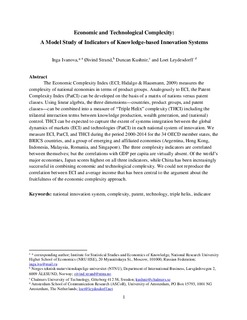| dc.description.abstract | The Economic Complexity Index (ECI; Hidalgo and Hausmann, 2009) measures the complexity of national economies in terms of product groups. Analogously to ECI, the Patent Complexity Index (PatCI) can be developed on the basis of a matrix of nations versus patent classes. Using linear algebra, the three dimensions—countries, product groups, and patent classes—can be combined into a measure of “Triple Helix” complexity (THCI) including the trilateral interaction terms between knowledge production, wealth generation, and (national) control. THCI can be expected to capture the extent of systems integration between the global dynamics of markets (ECI) and technologies (PatCI) in each national system of innovation. We measure ECI, PatCI, and THCI during the period 2000–2014 for the 34 OECD member states, the BRICS countries, and a group of emerging and affiliated economies (Argentina, Hong Kong, Indonesia, Malaysia, Romania, and Singapore). The three complexity indicators are correlated between themselves; but the correlations with GDP per capita are virtually absent. Of the world's major economies, Japan scores highest on all three indicators, while China has been increasingly successful in combining economic and technological complexity. We could not reproduce the correlation between ECI and average income that has been central to the argument about the fruitfulness of the economic complexity approach. | nb_NO |
